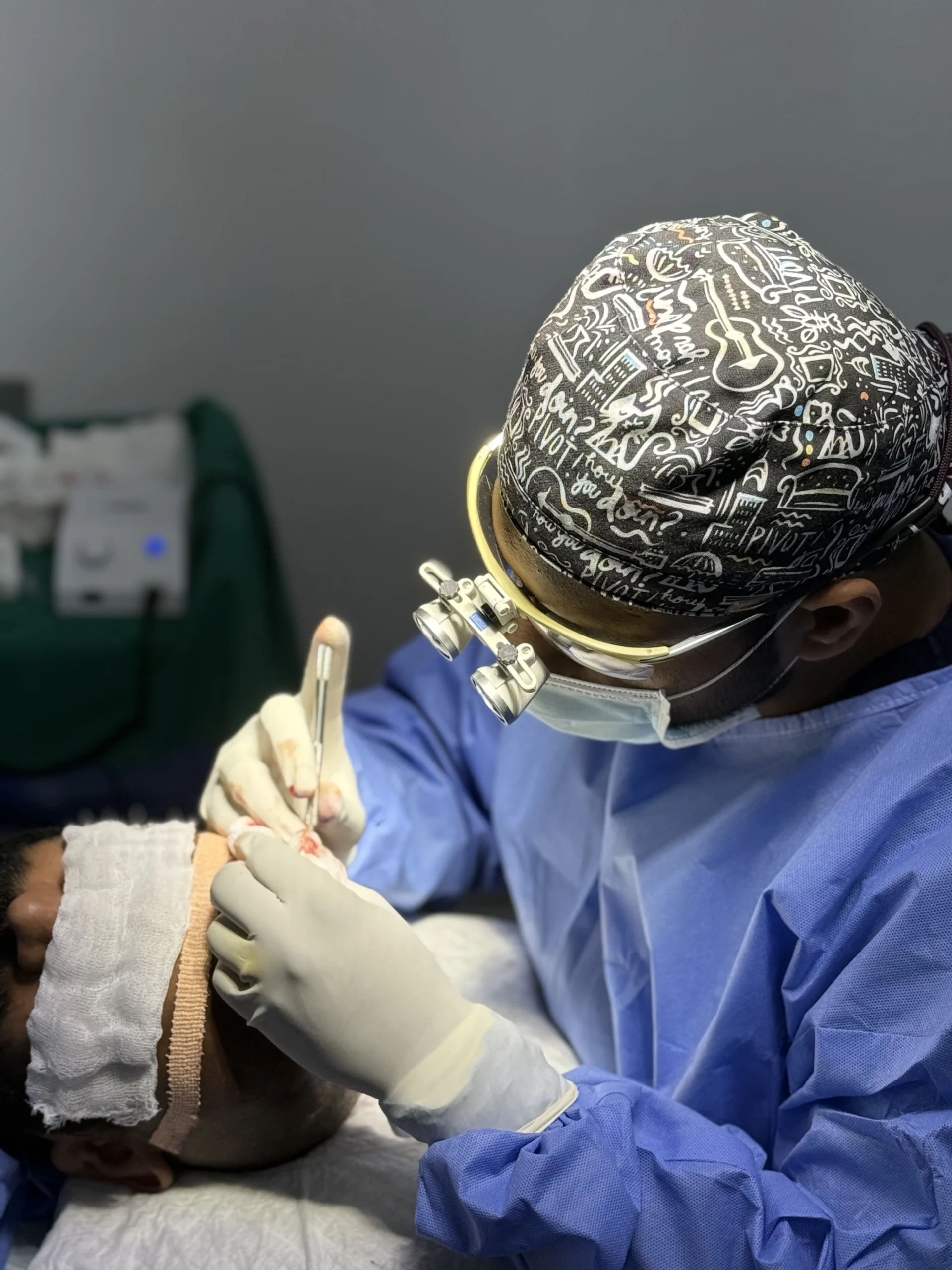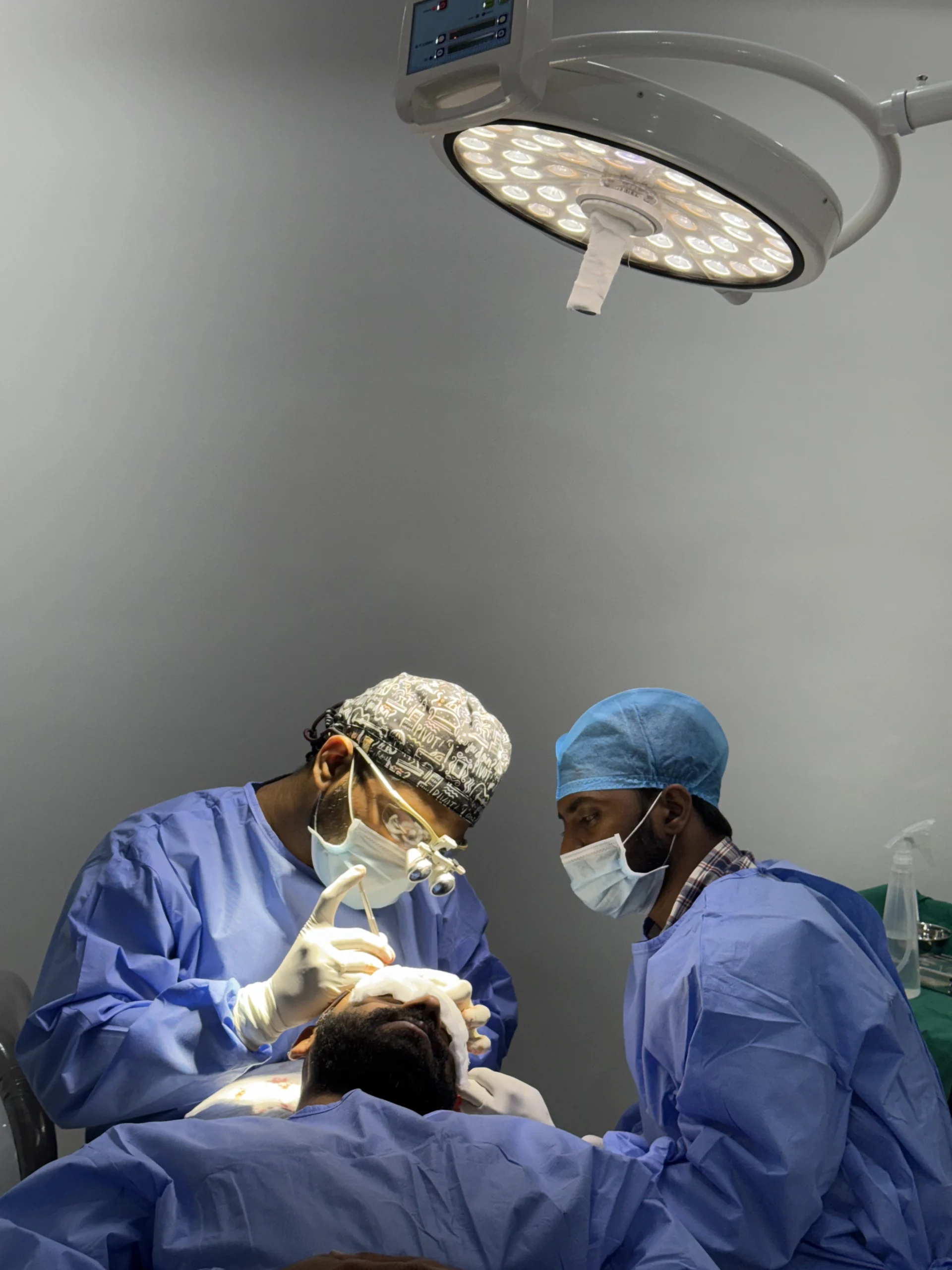Male Hair Transplant – Dr. Anirudh’s Advanced Hair Clinic
Experience safe, permanent solutions for hair loss with modern FUE and DHI techniques, expert care, and seamless recovery—all delivered by a renowned clinical team in Hyderabad.
What Is Male Hair Transplant?
Male hair transplants restore natural, dense hair using precision FUE (Follicular Unit Extraction). This cosmetic procedure is ideal for men experiencing male pattern baldness, receding hairlines, thinning hair crowns, and patchy facial hair.
Common causes of hair loss in men include:
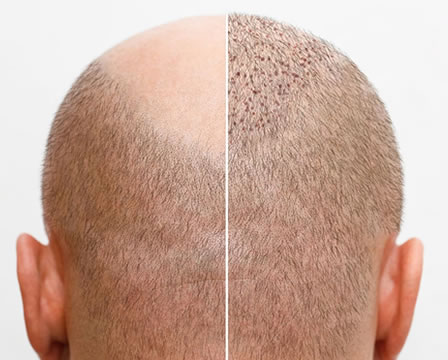
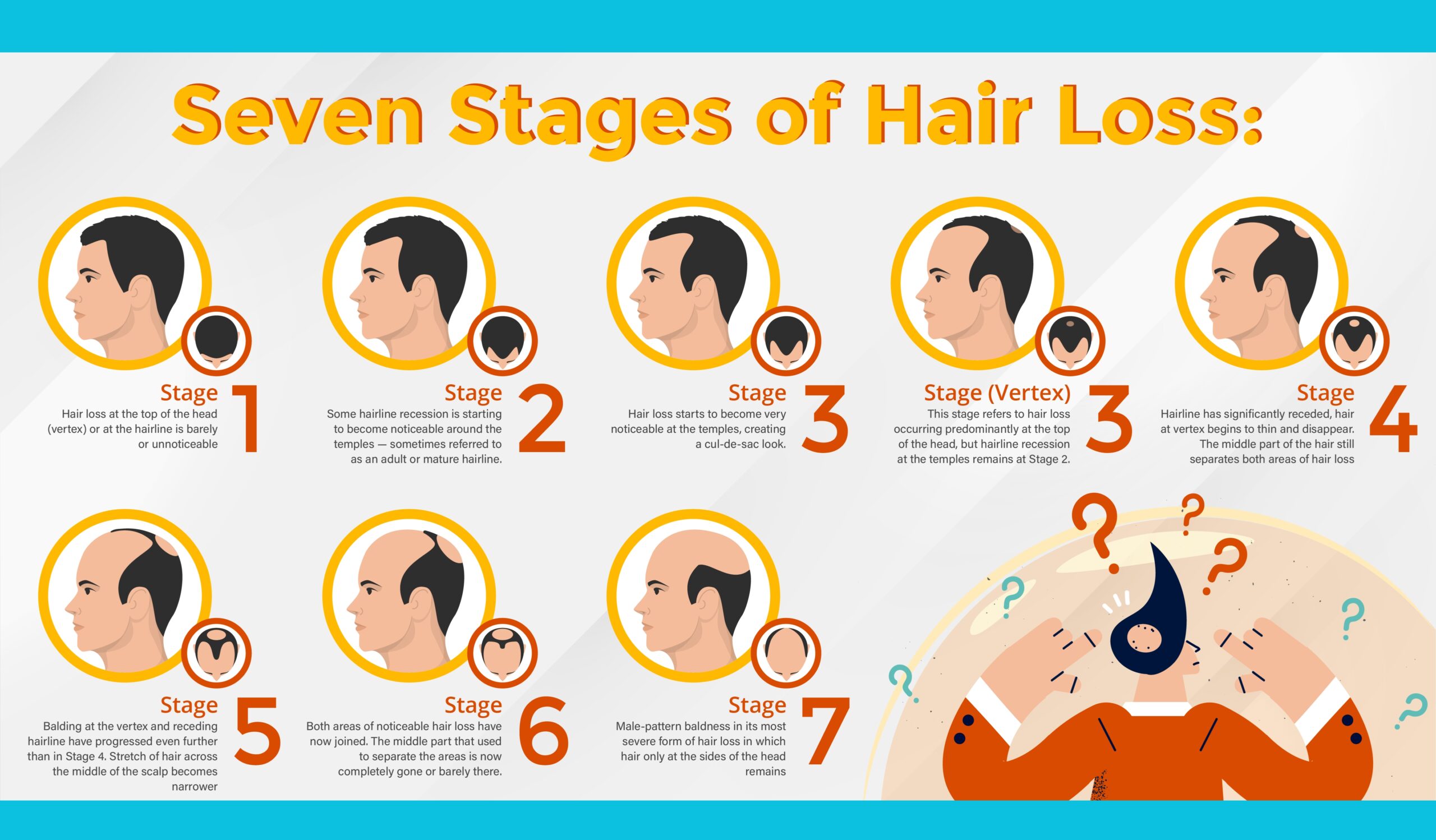
Stages of Male Pattern Baldness
Baldness advances in clear stages (Norwood Scale):
Stage 1
Hair loss at the top of the head (vertex) or at the hairline is barely visible or unnoticeable.
Stage 2
Some hairline recession becomes noticeable around the temples, known as the adult or mature hairline.
Stage 3
Hair loss starts to become very apparent at the temples, giving a cul-de-sac appearance.
Stage 3 (Vertex)
Hair loss occurs mainly at the top (vertex) of the head, while recession at the temples stays at Stage 2.
Stage 4
Hairline recession is quite significant, and the hair at the vertex thins or disappears. The midline of the scalp still separates both balding areas.
Stage 5
Balding at the vertex and receding hairline has advanced further than in Stage 4. The strip of hair between the areas of loss becomes narrow.
Stage 6
Noticeable hair loss areas have now joined. The midline strip is gone or almost gone.
Stage 7
Male pattern baldness is now most severe. Only hair on the sides of the head remains; the top is almost completely bald.
Hair Transplant Techniques We Offer
FUE Hair Transplant
FUE is the most popular, minimally invasive hair transplant procedure for men. In this process, individual hair follicles are extracted from healthy donor zones—usually the back or sides of the scalp—using a specialized punch. These follicles are then artistically implanted in thinning or balding areas, resulting in completely natural hair growth and nearly invisible scarring. FUE is ideal for men who want quick recovery, undetectable results, and the option to wear short hairstyles.
FUE Advantages for Men
The FUE (Follicular Unit Extraction) method is a top choice for men seeking a permanent and natural-looking solution to hair loss. Its key advantages include:
-
Minimally Invasive: Unlike older methods, FUE doesn’t require a linear incision, which means no stitches and no visible linear scar. This makes it ideal for men who prefer to wear their hair short.
-
Natural-Looking Results: Hair follicles are individually harvested and implanted, allowing for precise control over the hairline’s design and density. This ensures the new hair grows naturally and is virtually undetectable.
-
Faster Recovery: The tiny extraction sites heal quickly, and most men can return to their normal routine within a few days.
-
Versatile Donor Area: FUE allows for the harvesting of grafts not only from the scalp but also from other body parts if needed, providing flexibility for extensive hair loss cases.
DHI Hair Transplant
DHI is an advanced evolution of FUE. Using a unique implanter pen, grafts are immediately placed into the recipient site with perfect direction, angle, and depth—ensuring high survival rates and the most natural look possible. DHI helps achieve improved hair density and perfect hairlines with no stitches or scars. This method is often chosen for hairline reconstruction, crown restoration, and those seeking the utmost precision .
Advantages of DHI for Men
The DHI (Direct Hair Implantation) method is an advanced evolution of FUE, offering a highly precise approach to male hair restoration. Its key advantages include:
-
Precision and Perfect Hairlines: The DHI method uses a specialized implanter pen that allows for exact control over the angle, depth, and direction of each hair follicle. This is crucial for creating a natural, undetectable hairline.
-
High Density and Natural Results: DHI allows for a higher concentration of grafts to be placed in a smaller area, delivering a fuller, denser look to balding areas like the crown and frontal region.
-
Minimal Scarring & Quick Recovery: The procedure does not require pre-made incisions, leading to a quicker recovery and no visible linear scars, which is ideal for men who prefer shorter hairstyles.
-
High Graft Survival Rate: Since follicles are immediately implanted after extraction, their time out of the body is minimized, ensuring a high survival rate and a more successful transplant.
Our Process
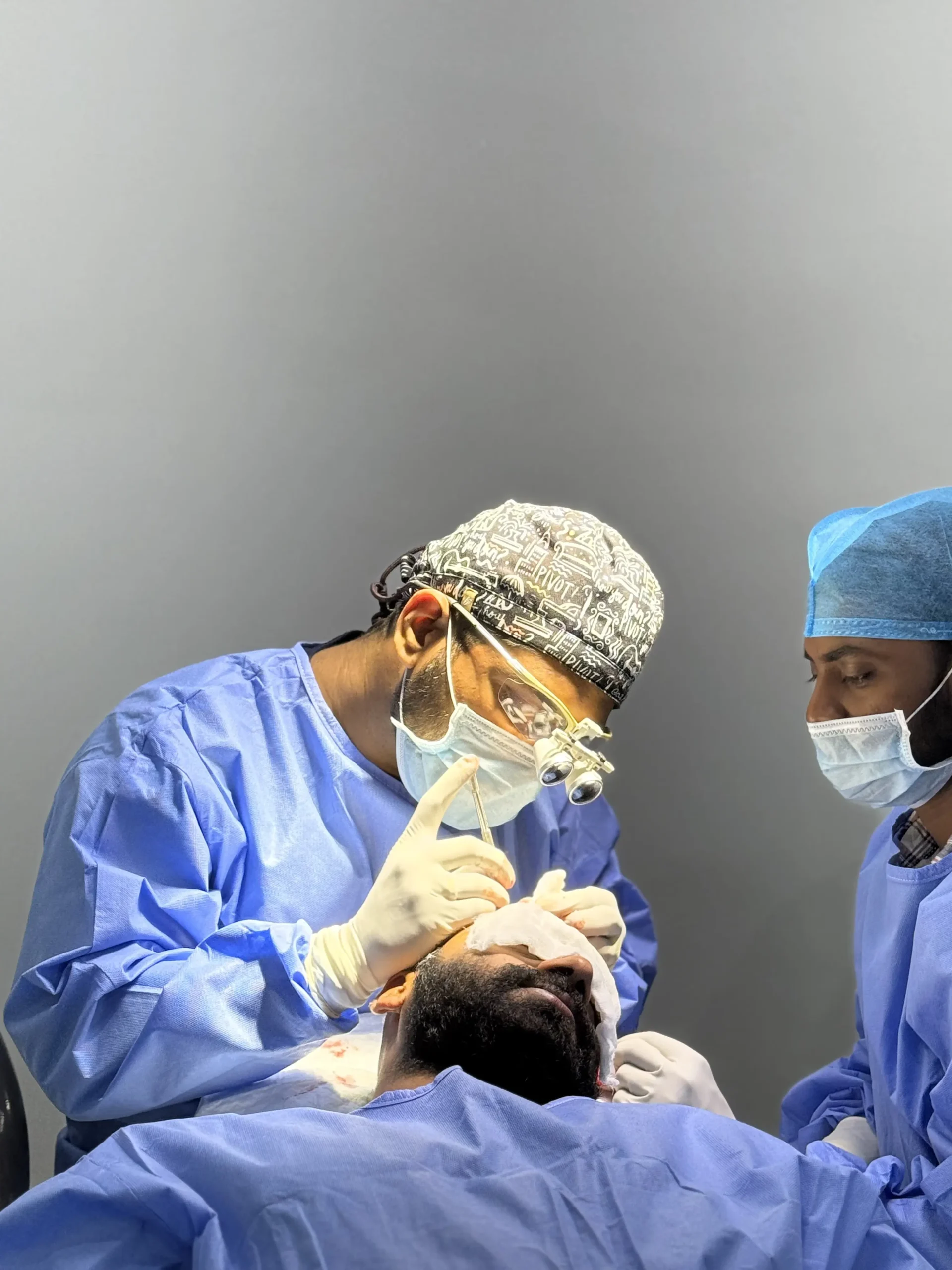
-
Comprehensive Consultation:
Your journey starts with an in-depth evaluation of your scalp, hair loss pattern, and medical history. Dr. Anirudh creates an individual plan based on the Norwood-Hamilton Scale. -
Donor Area Assessment and Extraction:
For both FUE and DHI, donor hair is harvested from DHT-resistant zones (usually the back of the scalp or beard) using micro-punches, ensuring minimal trauma and the highest graft quality. -
Recipient Site Creation and Implantation:
-
FUE: Incisions are created and grafts are strategically implanted for natural flow and density.
-
DHI: Using the patented implanter pen, grafts are directly inserted into the scalp in a single step, optimizing survival and precision.
-
-
Aftercare & Recovery:
Most patients return to normal life within days, with new hair growth beginning as soon as three months and full, permanent results within 12–18 months. Our team provides complete aftercare guidance at every step.
Healing & Recovery Timeline
-
First Week: Donor area usually heals within a week; recipient area takes 7–30 days for grafts to fully attach.
-
Normal Symptoms: Mild redness, swelling, crusting, dryness, itching, or heaviness—these clear up within days.
-
Long-Term: New hair growth starts at 3–6 months, full results visible by 12–18 months.
-
Aftercare: Detailed instructions provided; regular follow-ups ensure best regrowth and health of new hair.
Ideal Candidates for Hair Transplant
-
Men with stable hair loss and sufficient donor hair at the back or sides of the scalp
-
Those with male pattern baldness, receding or uneven hairlines, thinning crown, or patchy beards
-
Individuals in good overall health with realistic expectations

Benefits of Hair Transplant Surgery
-
Quick recovery: Most patients resume daily routines within days
-
Minimum pain: Modern FUE and DHI methods use local anesthesia, minimizing discomfort throughout the process
-
Natural, dense results: Precision placement and the latest extraction/implant technologies give you an authentic, full hairline
-
Youthful appearance: Restoring your hair improves self-confidence and overall look
-
Versatility: Suitable for small corrections (hairline, patchy beard) and extensive procedures (crown, temple restoration)
-
Permanent solution: Transplanted hair is immune to future pattern baldness
Hair Transplant Risks & Complications
Like any medical procedure, there are risks:
-
Temporary numbness, swelling or discomfort at donor/recipient sites
-
Minimal scarring (rare with expert FUE/DHI)
-
Infection (rare with proper hygiene and skilled surgeons)
-
Bleeding or minor inflammation
-
Slight loss of graft survival (addressed during aftercare)
Experienced clinics and proper aftercare minimize risks and ensure the highest rate of successful, natural results.
Dr. Anirudh’s Hair Clinic leverages advanced FUE and DHI for every step—from consultation to aftercare—ensuring safety, comfort, and lasting confidence.
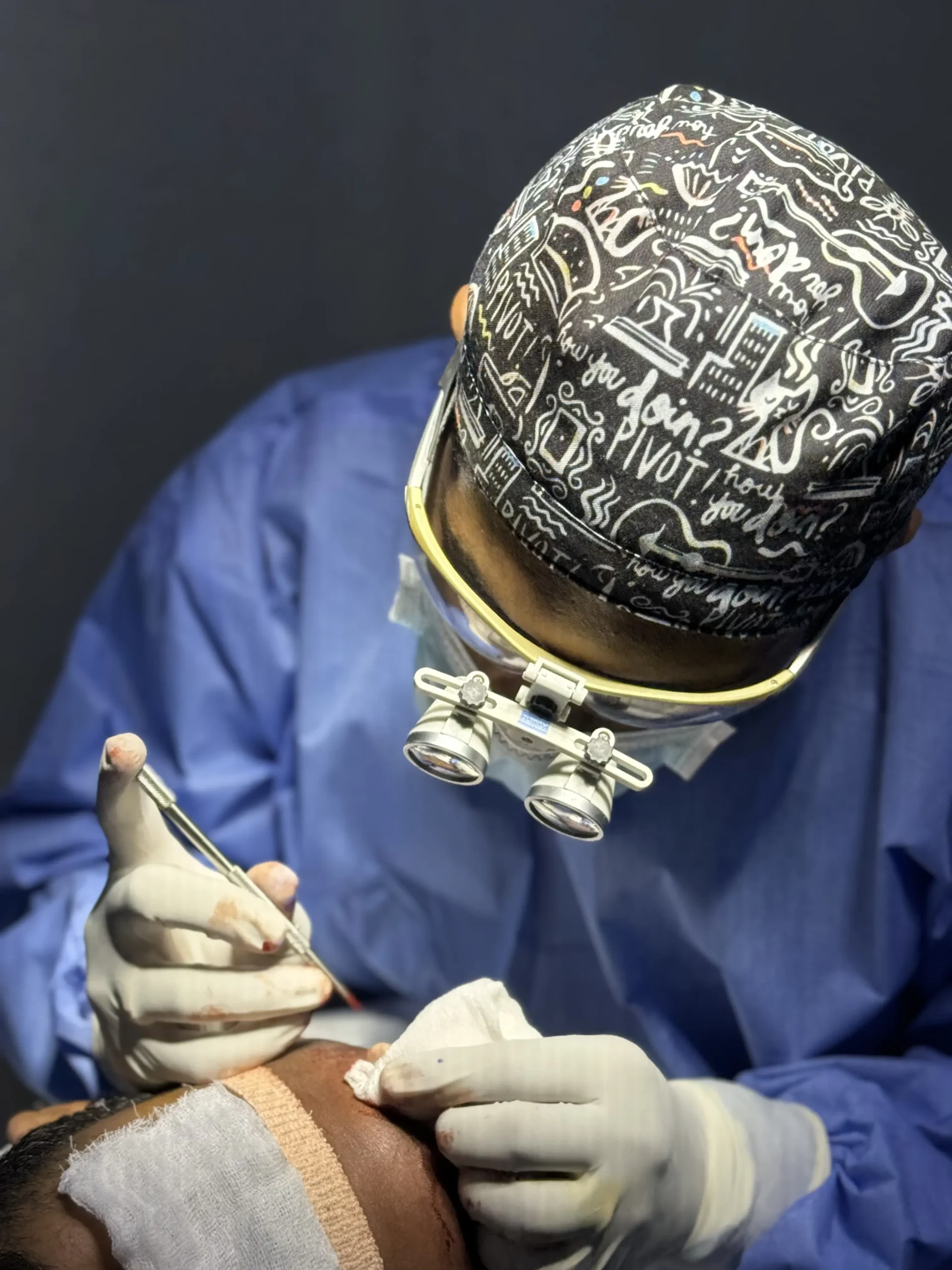
Why Choose Dr. Anirudh?
With over 10 years of intensive experience, Dr. Anirudh stands as one of Hyderabad’s foremost hair transplant surgeons. He holds an MBBS and an MD in Dermatology from the prestigious Rajiv Gandhi University, further solidifying his expertise with specialized Fellowships in Hair Transplantation and Aesthetic Medicine. As a proud member of FUE Asia, he reflects an unwavering dedication to advanced, ethical, and cutting-edge hair restoration practices.
Dr. Anirudh has personally performed over 1000 successful hair restoration surgeries, earning a stellar reputation for his exceptional precision, artistic vision, and unwavering commitment to patient comfort. He understands that each patient’s journey is unique, which is why every treatment plan is meticulously customized to individual needs—whether addressing male pattern baldness, receding hairlines, crown thinning, or patchy facial hair.
Combining advanced FUE and DHI techniques with genuinely compassionate care, Dr. Anirudh consistently ensures natural, dense, and aesthetically pleasing results. Patients benefit from minimal discomfort and quick recovery times, further supported by his dedication to empowering them through comprehensive education and personalized aftercare. At Dr. Anirudh’s clinic, your journey to renewed confidence and natural hair growth is guided by unparalleled expertise and heartfelt commitment.
Expert Insights: Hair, Skin & You
Expert advice for healthy hair and radiant skin.
Visit Us
Book Your Appointment Today!
Don’t let hair loss control your life. Take the first step with a comprehensive, confidential consult at Dr. Anirudh’s Hair Clinic—Hyderabad’s trusted destination for advanced FUE/DHI hair restoration.

